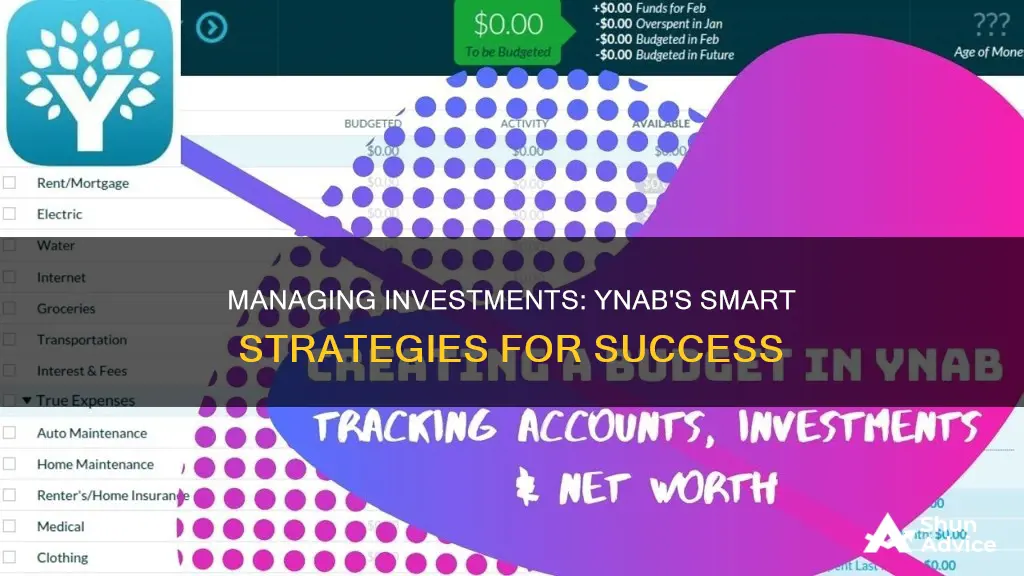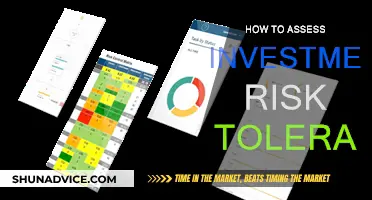
YNAB, or You Need A Budget, is a hands-on budgeting app that requires proactive management of your money. While the app does not offer an easy way to track investments, you can still use it to manage your investments by adding them as tracking accounts. You can also create a category for each of your funds and a separate savings/checking account for your trading account. Additionally, you can set up a monthly target or a by date target for your investments, depending on your payment schedule and contribution amounts.
| Characteristics | Values |
|---|---|
| Cost | $14.99 per month or $109 per year |
| Investment tracking | No easy way to track investments |
| Investment performance | No sync with investment accounts |
| Investment balances | Can be manually entered |
| Investment accounts | Can be added as tracking accounts |
| Investment categories | Can be created for each investment account |
| Investment targets | Can be set as monthly or by date |
| Investment reconciliation | Can be done manually to account for market fluctuations |
What You'll Learn

Add investment accounts to your tracking accounts
Investment accounts can be more difficult to track in your budget. Although you’re tracking your contributions and any funds you pay from your checking account, you may also want to keep an eye on the market value of the investment account since it fluctuates.
To add investment accounts to your tracking accounts in YNAB, follow these steps:
- Get creative with the account name. You can use emojis to indicate that the tracking account is a fluctuating account depending on the market. For example, use the up-graph emoji and label it with the name of the account holder.
- Add a category and a target for each investment account. Your contributions to these accounts are considered transfers from your checking account (a budget account) to your investment account (a tracking account), so you’ll need a category to categorise transactions where funds leave the budget. You can make a category group for Investments and then give each account its own category.
- Choose a target option that suits your payment schedule and contribution amounts. You can set a monthly target for regular contributions or choose the “By Date” option if you want to hit a specific target by a certain date but make different contributions each month.
YNAB also offers a wealth of educational content, including a blog, free workshops, and guides to help you make the most of the app.
Investment Managers: New Products, Alpha Generation?
You may want to see also

Create categories for investments
Creating categories for investments is a crucial step in effectively managing your investments in YNAB. Here's a detailed guide to help you through the process:
Understanding Categories in YNAB
Before creating categories for your investments, it's important to understand what categories are and how they work in YNAB. Categories in YNAB are like folders or labels that help you organize and track your spending. They allow you to allocate your money to specific areas, such as groceries, rent, or investments. Each category can have its own name, and you can create as many categories as you need to reflect your financial priorities.
Creating Categories for Investments
Now, let's dive into the process of creating categories specifically for your investments:
- Identify your investment types: Start by identifying the different types of investments you have or plan to have. For example, you might have investments in mutual funds, ETFs, stocks, bonds, or retirement accounts. You can create categories for each of these investment types.
- Navigate to the Categories section: Log in to your YNAB account and find the "Categories" section. This is where you will create and manage your investment categories.
- Create a new category: Click on the "Create a Category" button or a similar option within the Categories section. This will open a form where you can enter the details of your new category.
- Name your investment category: When creating a category for investments, it's a good idea to give it a clear and descriptive name. For example, you might name your categories "Mutual Funds," "Retirement Account," or "Stocks." This will make it easier to identify and track your investments.
- Set a target for your investment category (optional): YNAB allows you to set targets for your categories, which can be helpful in reaching your investment goals. You can choose from different types of targets, such as a monthly target ("Set it and forget it") or a target with a specific deadline ("By Date"). Select the option that aligns with your investment strategy.
- Repeat the process for each investment type: If you have multiple types of investments, repeat the above steps to create a category for each one. For example, if you invest in both mutual funds and ETFs, create separate categories for each.
- Allocate funds to your investment categories: Once your investment categories are set up, it's time to allocate money to them. Decide on the amount you want to contribute to each investment category and transfer the funds accordingly. You can do this by creating a transaction in YNAB, treating it as a transfer from your budget account to your investment account.
- Reconcile and track your investments: Remember to update your investment categories regularly to reflect market fluctuations and any transactions you make. YNAB allows you to reconcile your accounts and track the performance of your investments over time. This helps you stay informed about the value of your investments and make adjustments as needed.
By following these steps, you can effectively create and manage categories for your investments in YNAB. This will help you stay organized, track your progress, and work towards your financial goals.
Saving Plans: The Benefits of a Conservative Financial Strategy
You may want to see also

Set monthly targets
Setting monthly targets is a crucial aspect of managing your investments using YNAB. Here are some detailed instructions and tips to help you set effective monthly targets:
Identify Your Investment Goals:
Before setting monthly targets, it's essential to understand your investment goals. Are you investing for retirement, a down payment on a house, or a specific purchase? Knowing your goals will help you set the right monthly targets.
Determine Your Investment Account Type:
Decide whether your investment account will be a budget account or a tracking account. A budget account is suitable for volatile investments like stocks, where you actively track contributions and withdrawals. A tracking account is better for less volatile investments, like mutual funds or bonds, where you monitor market value fluctuations.
Create a Category for Your Investment:
In YNAB, create a category specifically for your investment. This will help you track and manage your investment contributions separately from other expenses. You can even create a category group for "Investments" and then create individual categories for each investment account.
Set Your Monthly Target Amount:
Decide on the amount you want to invest each month. Consider your financial situation and how much you can comfortably set aside. Remember that you can always adjust this amount if your circumstances change.
Choose the Right Target Option:
YNAB offers two target options: "Monthly" and "By Date." The "Monthly" option is ideal if you plan to contribute the same amount each month. The "By Date" option is more flexible, allowing you to set an overall target and adjust your monthly contributions as needed.
Automate Your Investments:
Consider setting up automatic payments to your investment account. This will help ensure that your monthly targets are met without you having to remember to transfer funds manually each time.
Review and Adjust:
Periodically review your monthly targets to ensure they align with your investment goals and financial situation. Life circumstances can change, and the market may fluctuate, so be prepared to adjust your targets as necessary.
Remember that investing often involves risk, and the value of your investments can go down as well as up. Seek independent financial advice if you're unsure about the best approach for your specific situation.
Presenting an Investment Portfolio: Strategies for Success
You may want to see also

Reconcile to account for market fluctuations
As the market value of your investment account fluctuates, you may want to keep an eye on it. You can get YNAB to do the math for you to account for market fluctuations. Update your investments at the end of the month and click "No" for the reconciliation number. Then, enter the correct balance that your investment account shows that day. This will keep your Net Worth report up to date, and you won't have to enter any transactions to keep up with the market. The reconciliation will adjust it for you.
You can also update your investments more or less frequently, depending on your preference. Some people prefer to update their investments weekly, while others may only update them once a month or even less often. The important thing is to choose a frequency that works for you and to be consistent.
When updating your investments, make sure to enter the correct balance for your investment account. This will ensure that your Net Worth report is accurate and up to date. You can find the correct balance by checking your investment account on the day you are updating your investments.
In addition to updating your investment balances, you may also want to consider setting up a "Reconcile" account in YNAB. This can help you keep track of any gains or losses in your investments. You can reconcile this account by comparing the balance in YNAB to the balance in your investment account and making any necessary adjustments.
By reconciling your investment accounts and updating your investments regularly, you can stay on top of market fluctuations and make more informed decisions about your investments.
Maximizing Your Investment Portfolio: Strategies for Success
You may want to see also

Add a category for emergency funds
When it comes to managing your investments in YNAB, it's important to have a clear plan and track your progress. Here's how you can use YNAB to add a category for emergency funds:
Step 1: Understand the Purpose of an Emergency Fund
An emergency fund is a financial safety net that covers unexpected expenses. These can include job loss, home repairs, car repairs, medical bills, or pet emergencies. The idea is to have easily accessible savings to fall back on, so you don't have to rely on credit card debt or other high-interest borrowing options.
Step 2: Set a Savings Goal
The amount you aim to save for your emergency fund will depend on your personal circumstances. A common starting point is to save $1,000, but you may want to work towards having three months' worth of living expenses set aside. You can also include variable expenses, which will reduce the number of "emergencies" you need to fund.
Step 3: Create a Category for Emergency Funds
In YNAB, create a new category specifically for your emergency fund. You can give it a creative name, such as "Banana Stand" or "Strategic Reserve," to make it more fun and memorable. This category will be a dedicated place to allocate funds for unexpected events.
Step 4: Decide on Subcategories (Optional)
Some YNAB users choose to further break down their emergency fund category into subcategories. For example, you might have subcategories for "Medical Emergency," "Job Loss," "Car Accident," or "Homeowner's Claim." This approach can help you allocate funds more specifically and give you a clearer picture of your emergency savings.
Step 5: Set Savings Targets
For each subcategory, consider setting savings targets based on things like insurance policy deductibles or expected expenses. For example, you might want to save the equivalent of your car insurance deductible plus extra for potential repairs or maintenance. You can also set a target for your overall emergency fund, such as having three to six months' worth of income saved.
Step 6: Fund Your Emergency Category
Start allocating funds to your emergency category and its subcategories (if applicable). You can use small windfalls, such as tax refunds or bonuses, to boost your savings. You can also set aside manageable amounts each month to gradually build up your emergency fund.
By following these steps, you'll be well on your way to establishing an emergency fund category in YNAB. This will provide you with financial peace of mind and help you manage your overall investments and budgeting strategy.
Invest Wisely to Secure Your Dream Home
You may want to see also
Frequently asked questions
You can add your investment accounts to your YNAB Tracking Accounts. You can then add a category and a target for each investment account.
You can set a monthly target if you're contributing the same amount each month. Alternatively, you can set a target amount that you want to hit by a certain date and vary the amount you contribute each month.
You can update your investments at the end of each month and reconcile the correct balance that your investment account shows on that day.
You can either manually enter your balances or set up automatic bank and credit card account links.
It is recommended that you update your investment accounts in YNAB at the end of each month.







